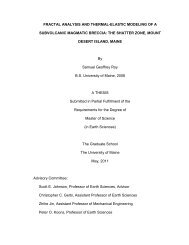Responses of Benthos to Changing Food Quality and Quantity, with ...
Responses of Benthos to Changing Food Quality and Quantity, with ...
Responses of Benthos to Changing Food Quality and Quantity, with ...
You also want an ePaper? Increase the reach of your titles
YUMPU automatically turns print PDFs into web optimized ePapers that Google loves.
<strong>Responses</strong> <strong>of</strong> <strong>Benthos</strong> <strong>to</strong> <strong>Changing</strong> <strong>Food</strong> <strong>Quality</strong> <strong>and</strong> <strong>Quantity</strong> 239<br />
<strong>and</strong> horizontal velocity show very strong gradients near the bed, producing<br />
diverse <strong>and</strong> <strong>of</strong>ten strongly vertically varying flux pr<strong>of</strong>iles (concentration x<br />
horizontal velocity = horizontal flux) . At first it would appear that active<br />
suspension feeders (such as clams) would be sensitive only <strong>to</strong> ambient<br />
concentration . Reinforcing the point made above this insensitivity <strong>to</strong><br />
flux should be observed only when supply overwhelms dem<strong>and</strong> . Interactions<br />
<strong>of</strong> the flux rates <strong>and</strong> geometries produced by pumping <strong>with</strong> the flux rates<br />
<strong>and</strong> geometries produced by the ambient flow become critical .<br />
It is thus apparent that rate <strong>of</strong> food supply-food quantity-cannot be<br />
defined accurately <strong>with</strong>out taking in<strong>to</strong> account <strong>to</strong> what organisms this rate<br />
is being supplied . For example, a benthic bacterium may depend upon<br />
vertical sedimentation <strong>of</strong> organic particulate carbon for its supply <strong>of</strong> chemical<br />
energy <strong>and</strong> vertical turbulent <strong>and</strong> molecular diffusive exchange <strong>of</strong> inorganic<br />
nitrogen <strong>to</strong> supply building blocks for proteins . A critical <strong>and</strong> unanswered<br />
question for both suspension feeders <strong>and</strong> deposit feeders in the deep sea is<br />
the extent <strong>to</strong> which they feed on a renewable resource in the form <strong>of</strong> such<br />
bacteria attached <strong>to</strong> particles versus the extent <strong>to</strong> which they compete <strong>with</strong><br />
bacteria for newly arriving <strong>and</strong> labile organic material . In the former case,<br />
their food supply is strongly buffered against short-term oscillations in rate<br />
<strong>of</strong> supply (<strong>with</strong> bacterial growth rate determining that supply), while in the<br />
latter these animals should be strongly keyed <strong>to</strong> vertical <strong>and</strong> horizontal<br />
sedimentation events <strong>of</strong> the most organically labile, new materials . Identifying<br />
precisely the food resources assimilated by deposit feeders is a key problem<br />
in shallow water as well as in the deep sea (Lopez et al . 1989) ; the problem<br />
is not straightforward because, at the high processing rates characteristic <strong>of</strong><br />
deposit feeders, a minor sedimentary organic constituent might be a major<br />
source <strong>of</strong> assimilated energy or mass even if it were assimilated <strong>with</strong> only<br />
moderate efficiency . The problems raised by this lack <strong>of</strong> knowledge are<br />
pervasive : if a downstream individual assimilates a different component <strong>of</strong><br />
sedimentary organic carbon from that assimilated by individuals <strong>of</strong> other<br />
species found upstream, then horizontal transport is all the more effective<br />
as a source <strong>of</strong> food .<br />
Any biologically useful definition <strong>of</strong> food quality must be even more<br />
closely tailored <strong>to</strong> the organism in question, as is obvious from Aesop's<br />
fable <strong>of</strong> the dog in the manger . One component <strong>of</strong> sedimentary food quality<br />
is the proportion <strong>of</strong> potentially digestible material in the food . A more<br />
specific definition is the volumetric or gravimetric concentration <strong>of</strong> the<br />
growth rate-limiting component, yet only for a h<strong>and</strong>ful <strong>of</strong> shallow-water<br />
species are there data <strong>to</strong> suggest what such components are (Tenore et al .<br />
1984) . This h<strong>and</strong>ful <strong>of</strong> results gives some hope that growth in deposit feeders<br />
may be limited more generally by either available (labile organic) nitrogen<br />
or available caloric energy, depending upon the ratio in which these two<br />
key ingredients are provided . To an organism, however, time is energy (or
















